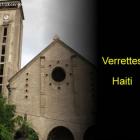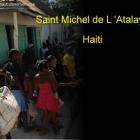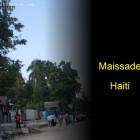ADVERTISEMENT
town - Haiti Observer Blog
town, Haiti Observer Blog. Read the following articles about town
Port-Margot, known for numerous rivers
The town of Borgne's other half in the Borgne Arrondissement located in the Nord Department is the municipality of Port-Margot. It is known for its numerous rivers, beautiful beaches, and mountainous geography. The municipality is composed of six sections, namely Bas-Petit, Bas-Quartier, Bras Gauche, Borgne Corail, Grande Plaine, and Haut Petit.
Port-Margot is home to about 37,000 Haitians who are mostly of Protestant faith. Most of them live a simple life, relying heavily on the municipality's many rivers for their livelihood. Rich vegetation is the most beneficial use of the rivers of Port-Margot, resulting to the heavy production cocoa and coffee. Historically, the municipality was Saint Dominque first French settlement. It is composed of several elementary schools and high schools, as well as a few health centres.
The town of Borgne known for simplicity
Haiti's Nord Department is the site of the most beautiful and breath-taking coastal cities and towns in the country. One of these is the small town of Borgne, known for its simplicity and its captivating beaches, as well as its thick flora and fauna. It is about 45 kilometres from the city of Cap-Haitien, the Nord Department's centre and capital.
Borgne, also referred to as Au Borgne, is home to about 60,000 Haitians that mainly rely on agriculture and fishery as their sources of income. The most common produce in the town are bananas, cocoa, coffee, and oranges. It has a library, a theatre, and a small hospitals sponsored by the Haitian government.
Milot, home of Sans Souci Palace
One of the Nord Department's municipalities is one of the most popular sites in the northern area of Haiti. Milot is a leading tourist attraction of the country, housing several historical landmarks and sites and having a rich history.
Milot is 20 kilometres from Cap-Haitien, a popular coastal city in the northern part of Haiti. In the 1800s, it was proclaimed as the country's first site capital by King Henri Christophe. Under King Henri I's rule, the beautiful Sans-Souci Palace was constructed from 1810 to 1813. The construction also included the building of eight smaller palaces, fifteen chateaus, several forts and summer homes, as well as twenty plantations, all owned and managed by the then royal family. The Palace is the notorious site of King Henri I's suicide in 1820. In 1842, it was destroyed by a strong earthquake and was never rebuilt. Despite its rough shape, it remains one of the most enamouring sites to see in Haiti, resulting in its designation as a UNESCO World Heritage Site in 1982.
The Open-Hearted People of L'Asile
L'Asile, a small village with a population of 32,000, is a cityship within the Ainse-a-Veau Arrondissement, part of Nippes Department.
The residents of L'Asile experience back-breaking poverty, earning only $300 USD each year. They derive their income from farming produce on small tracts of land. Bringing their crops to market provides them with enough money to keep them from starvation.
L'Asile is surrounded by hills, subject to grinding poverty, and many families make do with thatched-roof dwellings. For those who are able to afford the material, they build tin-roofed abodes. But whatever kind of housing they reside in, the population does not have either running water, or a dependable source of electricity.
Miragoane a Proud Community
Miragoane rests on the northern coast of the western peninsula of Haiti. As part of the Nippes Department and its capital, it is a main port of second-hand imports from Miami. At the port, merchants purchase imports and vend them at Miragoâne street stalls.
The history of Miragoane port, among the largest natural ports of the globe, was as a gathering place for the Spanish when the island was called Hispaniola. Eventually the French chased them out.
Miragoâne, ringed by mountains, is protected by Ile Gonave, which lies above it on an inlet of the Caribbean Sea. During its early history, gold was discovered and mined there.
Fonds-des-Negres and its Infrastructure
In the southern section of Haiti lies the cityship of Fonds-des-Nègres, which straddles both Miragoâne and Nippe Departments. The city, founded in 2003, was born of the capital city of Miragoâne. Three other communes make up Miragoâne: Bouzi, Pemerle, and Cocoyers-Duchene.
Roads in Fonds-des-Nègres are in very bad shape, many of them dirt roads. At this time, however, road-work projects are proceeding, the roads now being built and repaired to bring them up-to-date with current safety codes. In areas where heavy rains block passage of traffic because of spontaneous lakes created by the deluges, bridges are going up as well.
The Town of Savanette in Centre Department of Haiti
Savanette, a cityship within Lascahobas Arrondissement, is located in the Centre Department of Haiti. As a third-level administrative division, it contains two sub-divisions, Savanette and The Hague.
Possessing the typical tropic climate, green hills adorn Savanette with a refreshing and pure river that plummets down into a glen. At the base of the hills, a swimming site, known as Basin Longe, beckons natives with cooling waters on hot days. Before the building of a well in Savanette, residents were forced to trek hours to find water. Since Water 4 a Billion, a non-government organization, finished the well, the population has been saved the trouble of hiking many miles for access to clean water.
Town of Roseaux In Grand'Anse Department
In the Grand'Anse Department of Haiti is located a small village that is a municipality called Roseaux in the Corail Arrondissement. Around 34,617 people inhabit Roseaux. It is located at 76 meters altitude above the sea level between Jeremie and Corail covering 216.81 km2. Per km around 150 residents live in Roseaux.
Scenic Beauty And Ceremonies
Gommiers, Carrefour Charles, Pig Bottom and Grand Vincent are its four communal sections. This cove is enclosed with big rocks and beautiful bays along its shoreline lined with wooden boats.
Little kids love to play in the crystal clear shallow waters. Heavenly mountains, lush green vegetation and tall palm trees can be seen in the vicinity. Voodoo ceremonies were conducted in the huge dark caves on the mountains inhabited by bats.
Anse-d'Hainault in Haiti
Anse-d'Hainault, a cityship part of the Anse-d'Hainault Arrondissement and a third-tier directorate department in the Grand'Anse area, is located on the western tip of Haiti's peninsula. The city has a low-density population of 23,185 residents, and a low-humidity tropical climate. Its mineral-rich soil contains clay deposits, and its terrain is studded with farmlands and indigenous vegetation. As elsewhere in Haiti, Anse-d'Hainault is a predominately Catholic community.
When the 7.0 magnitude 2010 earthquake shook Port-au-Prince and other regions in the country to their foundations, emotional shock waves reverberated throughout the world. In the aftermath of the cataclysmic event, no place has had a stronger response and made a fuller commitment to Haiti than Holy Trinity Catholic Church (HTCC).
Thomazeau, Keep Hope Alive
Thomazeau, a small village in the Croix-des-Bouquets Arrondissement, is under the Ouest Department. The population, numbering 52,017, experiences grinding poverty. Many of the homesteads house up to 13 occupants, living in cramped spaces, with probably no electricity or running water.
However, one non-government organization (NGO), The New Life Community Project of Thomazeau (NLCPT), has been operating several programs to give the residents fresh hope. NLCPT is helping the villagers de-contaminate their drinking water, get healthcare services, and attend school. NLCPT has also opened an orphanage for abandoned children, attended to the community's spiritual needs, and offered funding for other programs.
Road infrastructure is abysmal in Thomazeau. Like other small villages in Haiti, the roads remain unpaved and dangerous, owing to enormous potholes. When heavy downpours happen during the rainy season, the roads cannot be navigated at all.
Our objective is to share with you news and information about Haiti and the people of Haiti. Traditions, habits and the way we were or grew are alive in this site. We highly recommend that you Subscribe to our Newsletter and also share with us some of the things that are memorable and made us unique people.

 Haitian Thanksgiving
Haitian Thanksgiving  Verrettes, Haiti
Verrettes, Haiti  Saint Michel de L 'Atalaye
Saint Michel de L 'Atalaye  Maissade, Haiti
Maissade, Haiti  Life After Death
Life After Death